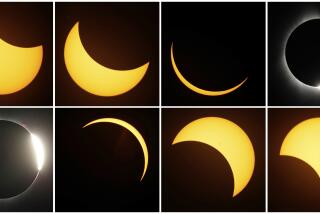50 years later, TV is still enamored of the Apollo 11 moonwalk
Retired astronaut Wally Schirra spoke for the world with his commentary for CBS News during the Apollo 11 moon landing on July 20, 1969: “Thank you, television, for letting us watch this one.”
A global audience of more than 500 million viewers tuned in for what was considered the greatest adventure in human history and the culmination of a national goal set by President John F. Kennedy in 1962 to get a man on the moon by the end of the decade.
The young sons of astronaut Neil Armstrong were in the living room of their Houston home, surrounded by friends and family, when their father descended from the lunar module onto the moon’s surface.
“We saw it on our state-of-the-art 26-inch color set,” Rick Armstrong said at a New York event to promote the Smithsonian Channel’s upcoming documentary “The Day We Walked on the Moon,” which premieres July 7.
Five decades later, viewers will be able to immerse themselves in the coverage again — or for the first time — in the weeks leading up to the 50th anniversary of the moon landing. CNN, Discovery Channel, National Geographic Channel, Smithsonian Channel, and PBS are airing special programs that feature rare footage of the voyage. TV news will offer coverage of the anniversary celebrations at the Kennedy Space Center near Orlando, Fla., and Apollo Mission Control Center in Houston.
VIEWER GUIDE: Get ready for the moon landing’s 50th with these 10 TV programs
Amy Entelis, executive vice president for talent and content development for CNN — which airs its theatrically released film “Apollo 11” on Sunday — believes the upcoming anniversary is a chance for viewers to see how a nation united at a time of deep divisiveness over the Vietnam War and social upheaval.
“It was a moment of time when we all came together, achieved something monumental and experienced it together,” Entelis said. “In the very tumultuous time we’re living in now, I think people are looking at our film and saying, ‘I’m nostalgic for a time when that was possible.’”
Network television news was a major partner in promoting the space program — as evidenced in Robert Stone’s three-part documentary “Chasing the Moon,” which debuts July 8 on PBS stations. In the pre-cable era of the 1960s, when CBS, NBC and ABC dominated the TV landscape, a captive audience watched largely uncritical coverage of the National Aeronautics and Space Administration’s launches and missions.
One constant in the upcoming Apollo 11 commemorations is vintage video and audio of CBS News anchor Walter Cronkite, an overt booster of the space program from the start. By the time Apollo 11 launched, he was the top-rated network anchor, surpassing longtime rivals Chet Huntley and David Brinkley on NBC. Cronkite’s audience for the moon landing surpassed the combined total for NBC and ABC and solidified his status as the dominant figure in TV news for the next decade.
For viewers who want a pure Cronkite experience on the Apollo 11 anniversary, CBS is mining its archives to present real-time footage of his coverage of events at the times they occurred. The launch will be shown on July 16 at 6:32 a.m. Pacific on the CBS News streaming service CBSN. Cronkite’s account of the moon landing and moonwalk will run on July 20 at 1:17 p.m. and 7:56 p.m. Pacific. Audio of the coverage will be carried on CBS News Radio.
Cronkite made himself an expert on the space program and explained the technical aspects with precision. But he also felt free expressing his wonderment at NASA’s achievements at a time when TV newscasters were generally stolid.
When Cronkite let out an emotional “oh boy” as the lunar module was 10 minutes away from the moon’s surface, Los Angeles Times TV critic Cecil Smith called it “an inelegant phrase, but it sounded like a prayer.”
“Cronkite owned the story,” said Kim Godwin, executive vice president for CBS News. “He experienced it as the viewers experienced it.”
Cronkite’s enthusiasm likely reflected the relief Apollo 11 provided after a string of relentlessly dispiriting stories news anchors brought into living rooms throughout 1968, including the assassinations of Robert F. Kennedy and Martin Luther King Jr. and growing polarization over the Vietnam conflict.
“The moonshot was the one place where Walter Cronkite’s patriotism could not be questioned,” said Michael Socolow, associate professor of communication and journalism at the University of Maine, and the son of Cronkite’s longtime producer, Sandy Socolow. “It was finally good news in the context of the Cold War and American innovation and ingenuity. It was kind of a restoration and looking ahead at the ’70s instead of the bad news of the ’60s.”
At the same time, the risk of the voyage meant the networks had to prepare for the worst possible outcome. As retired CBS News correspondent David Schoumacher notes in “The Day We Walked on the Moon,” his network had obituaries prepared for Armstrong and his colleagues Buzz Aldrin and Michael Collins.
While network television devoted dozens of consecutive hours to the Apollo 11 mission, there were long stretches with no live footage to show. News divisions used models and animation to depict much of what was happening. (Socolow said the re-creations fed into conspiracy theories that the moon landing was staged.)
Celebrity interviews and panels also filled the hours between the live shots of the launch and the black-and-white TV images, picked up by a 7 1/2-pound Westinghouse camera, that were beamed back to Earth from the moon.
CBS aired a segment with Orson Welles reminiscing about his “War of the Worlds” radio broadcast, which had panicked the country 31 years earlier with its tale of a Martian invasion. Welles told Mike Wallace that he would love to make a trip to the moon himself, but tipping the scale at 300 pounds made it unlikely. Over on ABC, jazz legend Duke Ellington introduced a new song called “Moon Maiden.”
CNN’s “Apollo 11,” which was released in theaters in March, offers viewers an unfiltered view of the voyage. Outside of some audio of Cronkite, there are no anchors or reporters describing the voyage and its aftermath, which are depicted almost entirely by recently discovered 70-millimeter film shot by NASA during the mission to serve as a record.
“Apollo 11” director Todd Douglas Miller had heard rumors that such footage existed but believed much of it was related to the NASA-commissioned production of a 1970 documentary called “Moonwalk,” which was released in 35-millimeter. After searching for several months, Miller was contacted by an archivist about sealed cans of 70-millimeter film sitting in cold storage at the National Archives, some of which were labeled “Apollo 11.”
“It wasn’t until we tested them at a postproduction house that we knew we had something,” said Miller. “The quality was the most stunning aspect of it.” Miller also was given access to 11,000 hours of audio of NASA mission control that encapsulate the entire nine-day Apollo 11 mission; these recordings provide nearly all of the dialogue in the film.
Entelis has anecdotal evidence that Miller’s approach will connect with younger viewers who have no knowledge or recollection of the moon landing.
“At one of the Sundance screenings, I was sitting next to a woman who looked to be 20 or 21 years old,” Entelis said. “I struck up a conversation with her, and she said the movie was fantastic. She said, ‘I loved the fact that there was no narration, that nobody was telling me what to think or talking heads telling me how important this was. I sat there as if it was just me watching this mission 50 years ago.’”
Entelis went on to ask whether the lack of additional information or data detracted from the film. “She said, ‘Nope, if I want to learn anything more about it, I’ll just go to Google and find it.’”
More to Read
The complete guide to home viewing
Get Screen Gab for everything about the TV shows and streaming movies everyone’s talking about.
You may occasionally receive promotional content from the Los Angeles Times.







